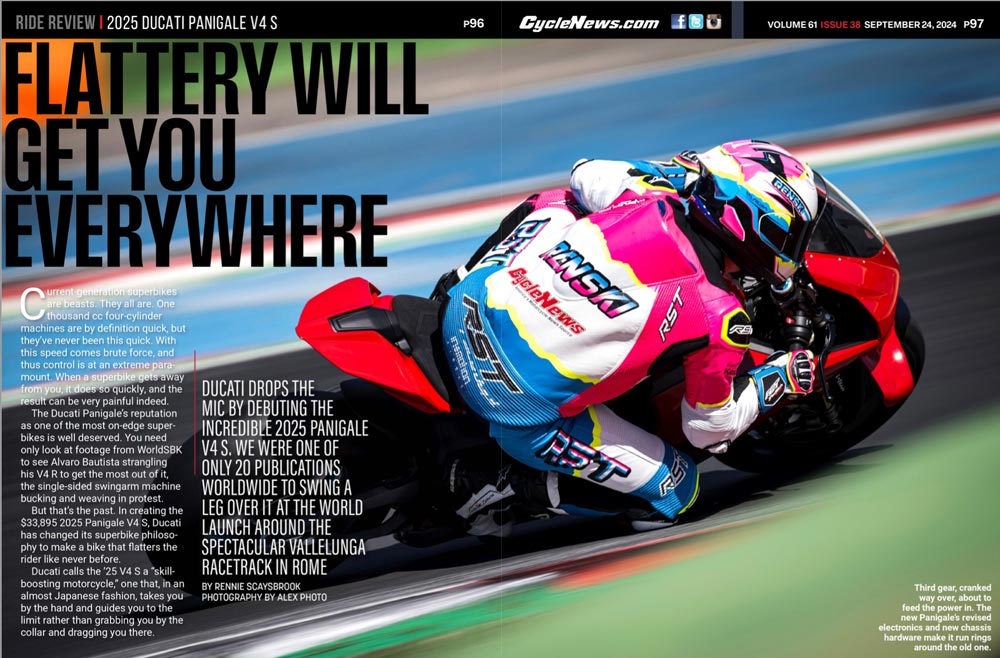Rennie Scaysbrook | September 29, 2024
Ducati drops the mic by debuting the incredible 2025 Panigale V4 S. We were one of only 20 publications worldwide to swing a leg over it at the world launch around the spectacular Vallelunga racetrack in Rome.
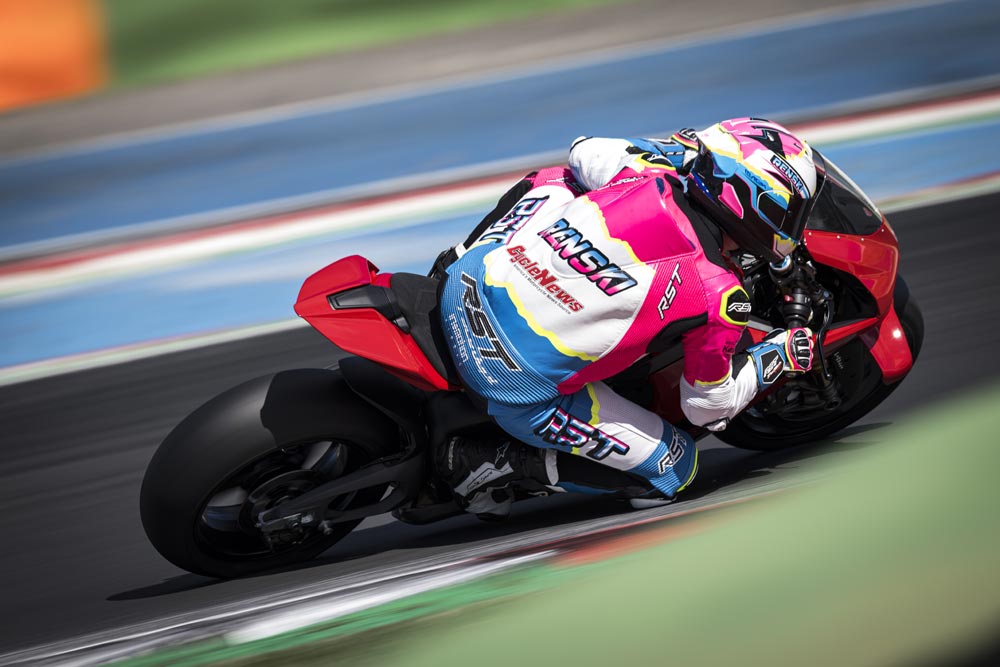 Third gear, cranked way over, about to feed the power in. The new Panigale’s revised electronics and new chassis hardware make it run rings around the old one.
Third gear, cranked way over, about to feed the power in. The new Panigale’s revised electronics and new chassis hardware make it run rings around the old one.
Photography by Alex Photo
Current-generation superbikes are beasts. They all are. One thousand cc four-cylinder machines are by definition quick, but they’ve never been this quick. With this speed comes brute force, and thus control is at an extreme paramount. When a superbike gets away from you, it does so quickly, and the result can be very painful indeed.
The Ducati Panigale’s reputation as one of the most on-edge superbikes is well deserved. You need only look at footage from WorldSBK to see Alvaro Bautista strangling his V4 R to get the most out of it, the single-sided swingarm machine bucking and weaving in protest.
But that’s the past. In creating the $33,895 2025 Panigale V4 S, Ducati has changed its superbike philosophy to make a bike that flatters the rider like never before.
Ducati calls the ’25 V4 S a “skill-boosting motorcycle,” one that, in an almost Japanese fashion, takes you by the hand and guides you to the limit rather than grabbing you by the collar and dragging you there.
As they say in the classics, flattery will get you everywhere.
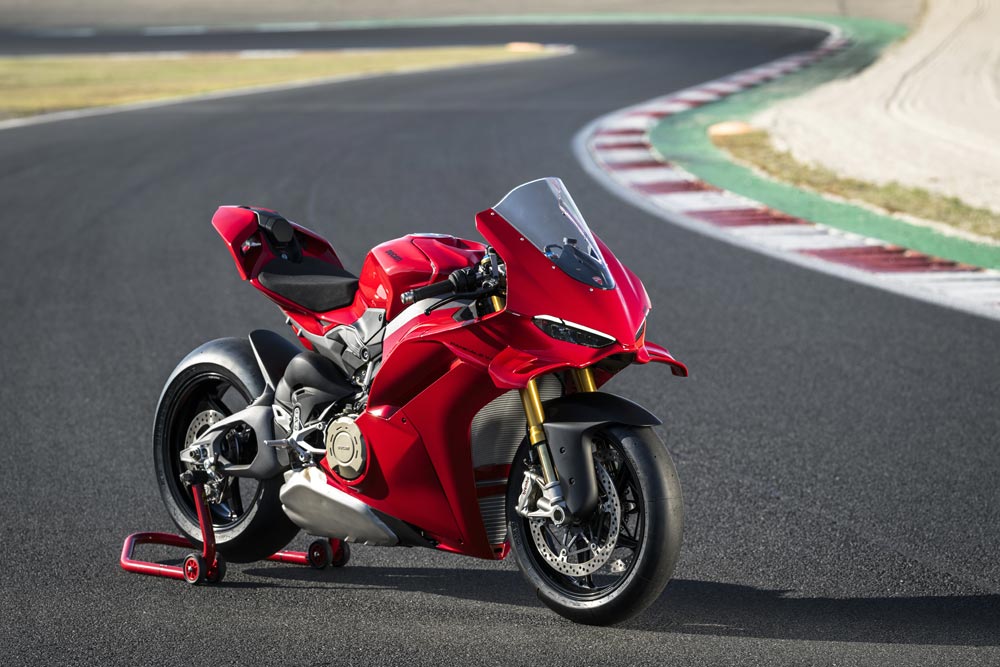 Polarizing? Possibly to purists, but every change, from the bodywork to the electronics to the all-new double-sided swingarm has made the Panigale faster and easier to ride at the limit.
Polarizing? Possibly to purists, but every change, from the bodywork to the electronics to the all-new double-sided swingarm has made the Panigale faster and easier to ride at the limit.
It does this due to two areas of improvement—vastly reduced chassis stiffness and a mixture of predictive electronics—but we’ll get into those in a moment.
The Panigale’s 1103cc, twin-pulse, counter-rotating crank, Desmosedici Stradale V4 is pretty much as it was from 2021, although bodywork and intake changes have necessitated new camshafts with higher lift than before and a revised cooling system.
Due to the intake changes, the variable length intake trumpets have changed slightly, down 10mm in the lower configuration and up 5mm when fully extended. There’s been other little tweaks as well, such as the alternator and oil pump being the same as the Panigale V4 R while the gearbox drum is the one used on the Superleggera V4.
Europe is luckier than us here in America, as their V4S’s get a claimed 216 hp while we get 209 hp, most likely due to tighter emissions regulations in places like California. Should you grab a Panigale and fork out the extra moolah for the Akrapovic racing exhaust that sounds like you’re a gazelle about to be eaten by a lion when a rider behind you closes in (I should know, I was the gazelle on track), you can count on a stunning 228 hp (claimed) nestled in your right hand.
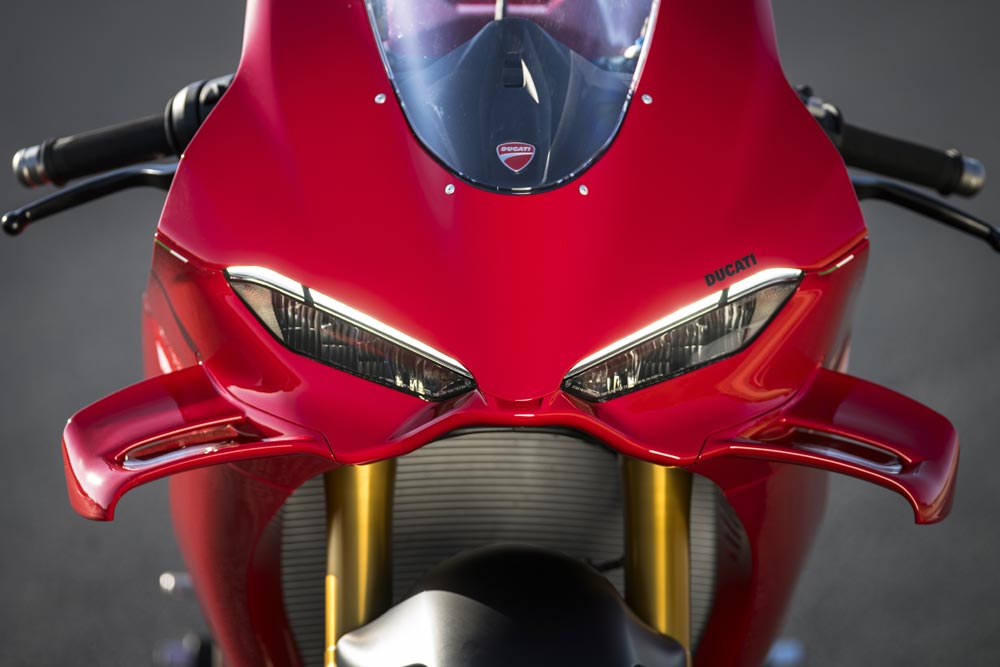 Ducati dug into its back catalog, namely the iconic 916, to mold the Panigale’s face. New winglets offer a similar amount of downforce as before but are far easier on the eye.
Ducati dug into its back catalog, namely the iconic 916, to mold the Panigale’s face. New winglets offer a similar amount of downforce as before but are far easier on the eye.
The engine has always been the strong point of the Panigale puzzle. A claimed 209 horsepower, one horsepower up on the 2024 model, is nothing to sneeze at, however, Ducati has increased the engine’s responsiveness at low rpm to make it a better street bike, because everyone knows you need 209 horsepower to ride to the shops.
The engine’s performance is metered by the riding modes Race A, Race B, Sport, Road, and Wet, each offering differing access to the engine’s full potential. However, even in Road mode, the 1103cc V4’s performance is monstrous. There are four different power modes: Full, High, Medium, and Low, the latter offering only 160 horsepower and a much softer throttle response).
Crank up the engine to full power, and the slightly dulled initial throttle response becomes iron fist hard, necessitating the rider to be fully and completely present.
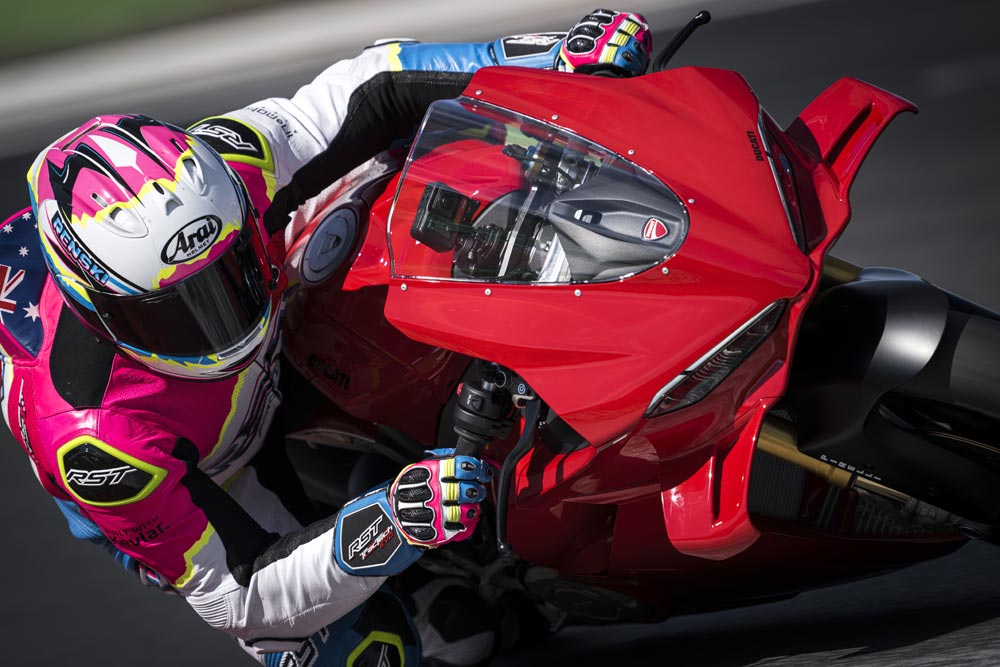 Side of the tire feel is vastly superior with the new Panigale. It also looks after its tires better than before, allowing more grip for longer.
Side of the tire feel is vastly superior with the new Panigale. It also looks after its tires better than before, allowing more grip for longer.
Full power mode ensures there’s no torque metering in the first three gears, allowing the motor to deliver its full force in all six gears. Ripping through the gearbox with the engine’s rpm north of 10,000 is a brain-melting experience. There’s so much forward force propelling you into your near future it’s genuinely hard for your senses to keep up. There’s no dip in performance, no lulling of power. It’s full fat all the time, but, again, it’s never been easier to get there.
The entire ride is metered by electronics. From the moment you ride out of pit lane at Vallelunga in Rome, you’re in the midst of various systems all working together, but at the pointy end of performance, Ducati’s new Ducati Vehicle Observer (DVO) system helps you keep the bike at the limit for longer, especially when the tire grip begins to fade.
The DVO system matches with the six-axis IMU to predict the behavior of the machine by the way you’re riding it and the forces going through it, using over 70 different sensors on the bike to allow more accurate intervention of the traction, slide and wheelie-control programs.
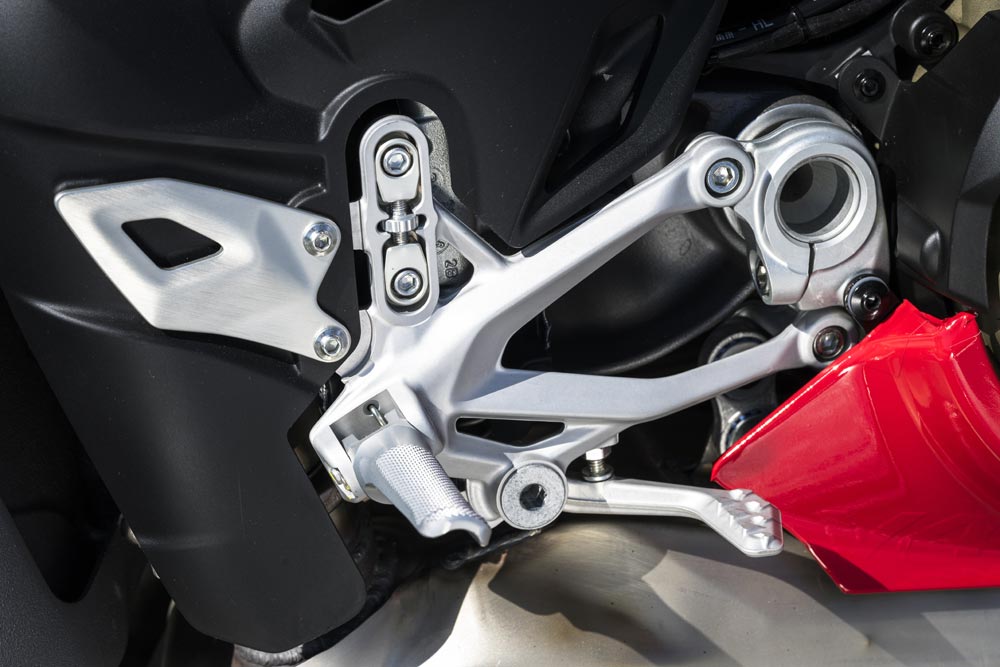 The new swingarm has enabled a redesign of the rider triangle. The footpegs are now mounted 10mm inwards, giving a tighter level of control.
The new swingarm has enabled a redesign of the rider triangle. The footpegs are now mounted 10mm inwards, giving a tighter level of control.
Think of the system like this: in a traditional system, traction, slide and wheelie control have their own preset parameters. In the DVO system, those parameters are variable, moving all the time based on the grip you’ve got and how hard you’re riding it. Almost like a dog pulling on a leash, the ECU is constantly calculating how much of a certain system to give to keep you in that sweet spot. Pretty cool, eh?
All that means at the handlebars you’ve got a bike that doesn’t buck and weave about like the old one did—well, not as much, at least. The Panigale’s acceleration is smoother than ever, allowing you to feed more power in, maximize the grip level and go faster.
The Panigale runs the new Ohlins Smart EC 3.0 event-based suspension, the successor to the first Panigale V4 that ran the EC 2.0 system way back in 2018. This system is now so good I’d have zero issue racing with it on a traditional track (perhaps not road racing like the Isle of Man, as the bike spends too much time in the air). Nothing much has changed in terms of adjustment—it’s all based on where you are in the corner, so braking, mid-corner and acceleration support, as opposed to compression and rebound damping. Preload is still changed in the traditional way with a wrench.
 The new 6.3” dash is something else. It’ll tell you everything from your lean angle to even how much power and how much torque the bike is making in real time.
The new 6.3” dash is something else. It’ll tell you everything from your lean angle to even how much power and how much torque the bike is making in real time.
Over the day I ratcheted the preload up two turns on the rear, one on the front, and maxed out the braking and acceleration support, resulting in a dream of a ride. The Panigale would charge into corners with the electronic suspension taking care of the braking and mid-corner balance, then, if I was in the right part of the corner, I would jam on the throttle hard and fast and let the traction, slide and wheelie control take care of the rest. It really is like playing a computer game, albeit one where there’s no respawn feature if you get it wrong.
Speaking of electronics, at Vallelunga, where enormous speed is met with high rpm downshifts, a curious trait started happening, where the exceptional work by Ducati’s engineers regarding the gearbox’s up and down quickshifter really shone through.
Barreling into the second-gear turn four right-hander, it became rather difficult to tell if the Panigale had gone into the right gear. The downshift action from the electronics is that smooth, sometimes (not all the time) I couldn’t tell if the next cog has been selected. Several times I needed to look at the dash to figure out if I was in the right gear, which is both a good thing and a bad thing because if you rely solely on engine braking and not the mechanical change in behavior that comes from back shifting at high rpm, you might get a little confused.
Of course, you’ve got variable engine braking control within the Ducati’s electronics, so you can alter it if you wish. I ran my EBC in level two of three, only trying the least and most engine brake once before settling on the middle ground.
 Brembo Hypure four-piston calipers with Cornering ABS EVO and Race e-CBS are now the standard bearer in the superbike class.
Brembo Hypure four-piston calipers with Cornering ABS EVO and Race e-CBS are now the standard bearer in the superbike class.
There’s another electronic gizmo that makes the Panigale a “skill booster,” and that’s the advent of the new Race eCBS, Ducati’s combined braking system that activates the rear brake at the same time as the front.
This is far from your standard Honda Gold Wing system that just adds rear brake when you’ve used the front. The Race eCBS system uses, again, info from the IMU, lean angle and front brake pressure from the astounding Brembo Hypure front brake calipers, to determine the correct amount of rear brake to apply for a given corner.
There’s three levels to the system, but in its proper race setting, you can feel the back of the bike squat as you get on the front brake and begin to turn in, effectively locking out the rear suspension and helping you pull the chassis into the apex. It’s a fantastic system if you, like me, struggle to use the rear brake while on track.
The good news is the system doesn’t mind if you are an adept rear brake user. If you ask for 15 bar of pressure via standing on the rear brake pedal and the system would only electronically give you 10 bar, you’ll get your 15 bar. Overall, the system allows for up to 15.5 percent of braking force to be applied on the rear of the bike.
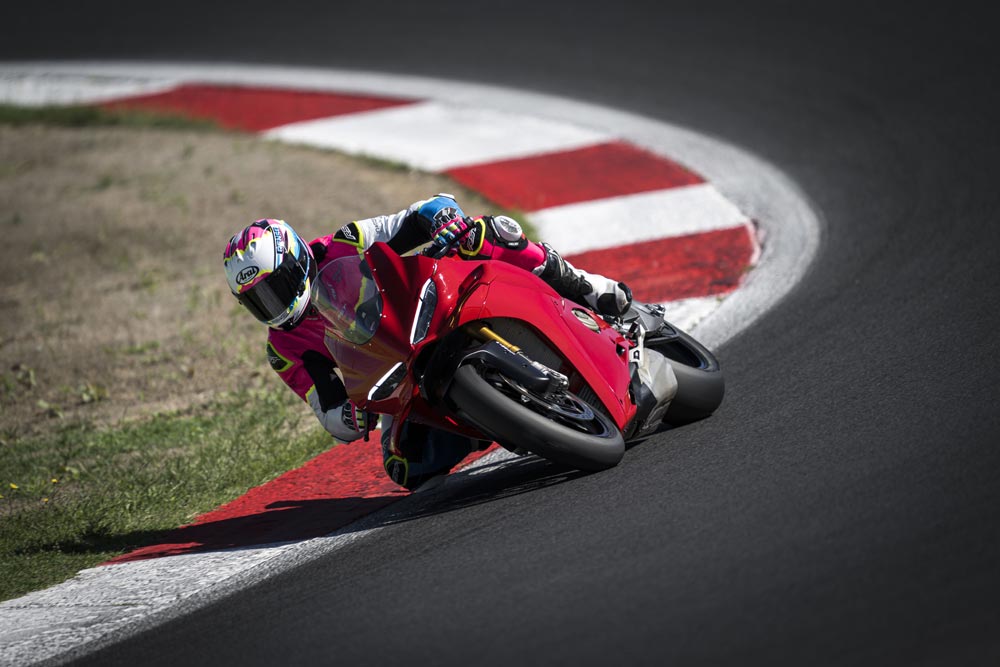 Ducati says the new Panigale is one second quicker than the old bike in the hands of Pecco Bagnaia. For the rest of us, that’ll translate into multiple seconds per lap.
Ducati says the new Panigale is one second quicker than the old bike in the hands of Pecco Bagnaia. For the rest of us, that’ll translate into multiple seconds per lap.
Levels one to five are designed for track riding, with combined braking is active on levels one and three, in the two different Track Plus and Track modes. Levels six and seven are dedicated to road riding.
This, above all the other claims Ducati has made with the 2025 Panigale, really does make it a skill boosting motorcycle.
The second part of why this Panigale is the easiest yet to gain access to the high-performance club comes down to the heavily-revised chassis.
Ducati has learned a thing or two in MotoGP. Remember when the red bike was the most hated on the grid and no one, save Australia’s demi-god Casey Stoner, could ride it? That bike was as stiff as a board, so rigid it needed to be ridden right on that ragged edge to work. Over the years the MotoGP Desmosedici got softer and softer, with more and more flex worked into the chassis. Flex means feeling, so the rider has more sense of what the tires are doing, where the grip is, and how best to exploit it.
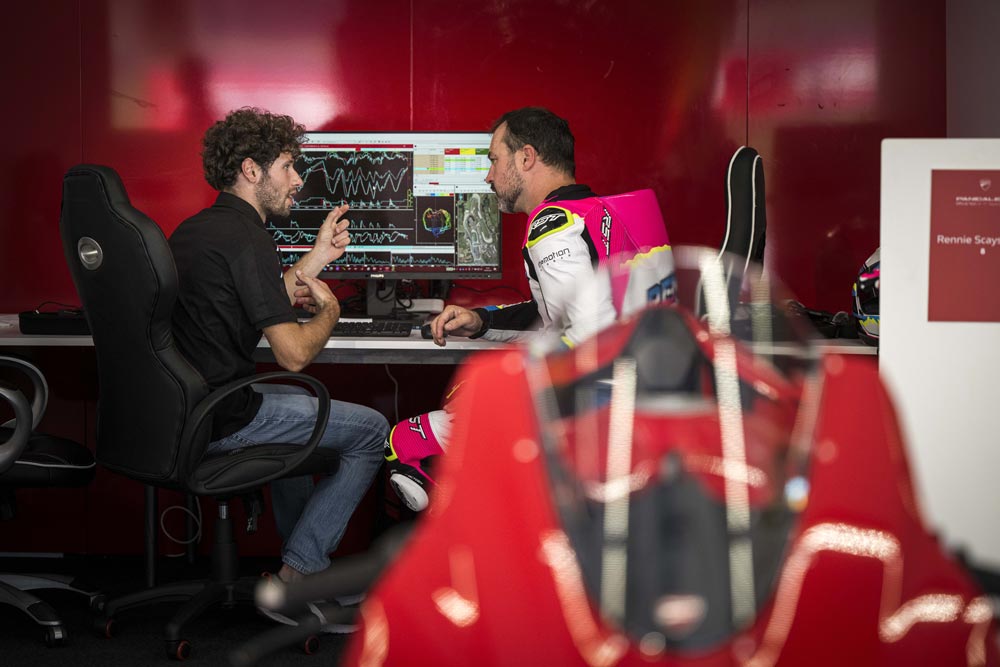 “Ah, Rennie, see here? This is where you need to stop being a wimp and open the throttle harder!” Ducati data engineer Andrea Lanfranchi goes through the Ducati Data Analyzer with Rennie.
“Ah, Rennie, see here? This is where you need to stop being a wimp and open the throttle harder!” Ducati data engineer Andrea Lanfranchi goes through the Ducati Data Analyzer with Rennie.
This emphasis on flex has been a cornerstone of the 2025 Panigale’s development, as has the employment of the double-sided swingarm. The V4 S’s front frame comes with a claimed 40 percent reduction in lateral stiffness, while the new swingarm has a claimed 37 percent less lateral stiffness. Combined, the new swingarm, suspension and rear wheel assembly is 8.38 lb lighter than before.
Those are massive numbers on paper, but they translate—just like the electronics—to a bike that’s plain easier to ride to for longer. The Panigale is still stiff, but nothing like it was last year or any time before that. The newfound flex matters at every point of the corner, but it is especially important at the mid-point where the brake begins to be bled off and the power fed back in. Now, the chassis filters some of the forces that make it to the tire out, allowing you to feed more power in faster and harder, thus allowing more mechanical grip from the tires to propel you forward.
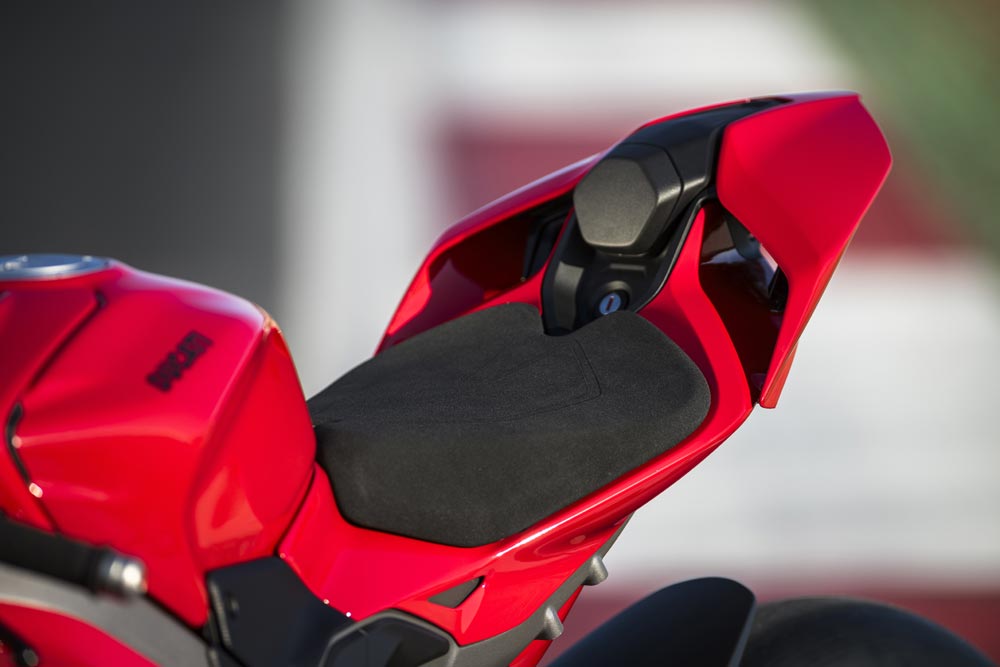 The rider’s seat has been slightly revised to give better support while at full lean.
The rider’s seat has been slightly revised to give better support while at full lean.
The new hollow swingarm is the result of three years of back-and-forth development with it and various single-sided versions. Remember, Ducati hasn’t fitted a double-sided swingarm to its lead superbike since the infamous 999 of 2003-2007, so for them to break with this tradition means the double-sided unit is clearly superior.
Having the extra stability of the double arm allowed for that reduction in lateral stiffness and a slight increase in wheelbase, the Panigale now enjoying the same feeling at the rear of the bike as many of its Japanese counterparts.
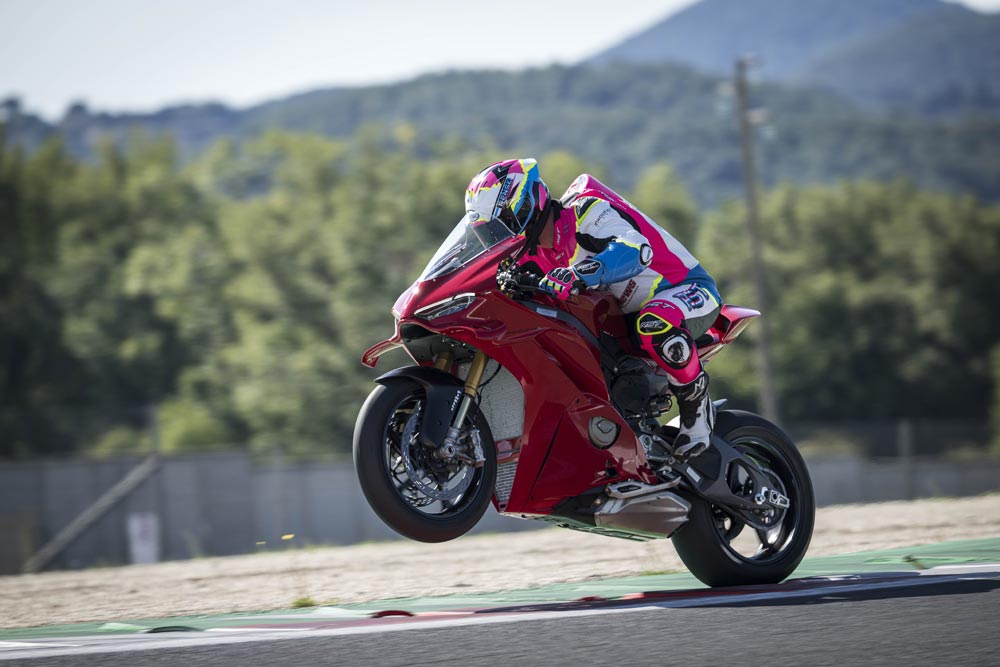 As an object of desire, the 2025 Ducati Panigale V4 S take a lot of beating.
As an object of desire, the 2025 Ducati Panigale V4 S take a lot of beating.
The 2025 Ducati Panigale V4 S is an astounding motorcycle. It’s the easiest 1000cc superbike I’ve yet ridden, but it’s also probably the fastest. Now Ducati has incorporated things like the DVO system and the Race eCBS, no doubt other manufacturers will follow suit, but—like aero winglets in MotoGP and production bikes—Ducati has broken the mold first.
For my skill level, the ’25 Panigale V4 S is impossible to fault. Maybe riders of a higher skill level than me could, but at my speed, I remain completely gob smacked at just how good this bike is. CN
VIDEO |2025 Ducati Panigale V4 S First Ride
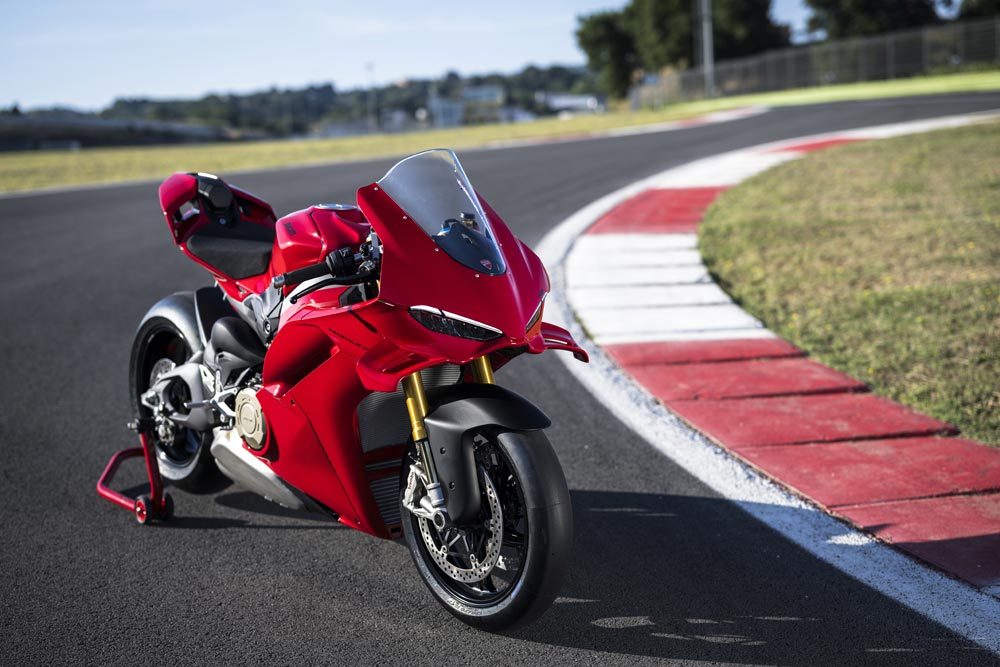
2025 Ducati Panigale V4 S Specifications
| MSRP |
$33,895 |
| Engine |
Desmosedici Stradale 90° V4, counter-rotating crankshaft |
| Valvetrain |
Desmodromic timing, 4 valves per cylinder |
| Cooling system |
Liquid |
| Fueling |
EFI |
| Displacement |
1103cc |
| Bore x stroke |
81 x 53.3 mm |
| Power (claimed) |
209 hp @ 12,750 rpm |
| Torque (claimed) |
89.5 lb-ft @ 11,250 pm |
| Electronics |
Three Riding Modes, Power Modes, Cornering ABS EVO, Ducati Traction Control (DTC) EVO 2, Ducati Wheelie Control (DWC) EVO, Ducati Slide Control (DSC), Engine Brake Control (EBC) EVO, auto tire calibration, Ducati Power Launch (DPL), Ducati Quick Shift (DQS) up/down EVO 2, Full LED lighting with Daytime Running Light (DRL), Ducati Electronic Suspension (DES) EVO with Ohlins suspension and steering damper, Quick adjustment buttons, Auto-off indicators, Race-eCBS |
| Transmission |
6-speed |
| Clutch |
Wet multi-disc |
| Chassis |
Aluminum alloy “Front Frame” |
| Front suspension |
Öhlins NIX30 43 mm fully adjustable fork with TiN treatment. Electronic compression and rebound damping adjustment with Öhlins Smart EC 3.0 event-based mode |
| Rear suspension |
Fully adjustable Ohlins TTX36 unit. Electronic compression and rebound damping adjustment with Öhlins Smart EC 3.0 event-based mode. Aluminum double-sided swingarm |
| Front-wheel travel |
4.9 in. |
| Rear-wheel travel |
5.1 in. |
| Front brake |
Dual 330 mm semi-floating discs, radially mounted Brembo Monobloc Hypure four-piston calipers with Cornering ABS EVO, Race e-CBS |
| Rear brake |
245 mm disc, twin-piston caliper with Cornering ABS EVO Last generation digital unit with five-inch TFT color display, Race e-CBS |
| Front tire |
Pirelli Diablo Supercorsa SP V4 120/70 ZR17 in. |
| Rear tire |
Pirelli Diablo Supercorsa SP V4 200/60 ZR17 in. |
| Seat height |
33.5 in. |
| Wheelbase |
58.5 in. |
| Rake |
24° |
| Fuel capacity |
4.49 gal. |
| Weight (wet, claimed) |
412 lbs. |
